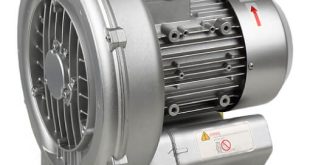screw type blowers
**1. Design and Mechanism
**a. Screw Mechanism
- Components: Consists of two interlocking screws (or rotors) that rotate in opposite directions.
- Function: As the screws rotate, they trap and compress the air or gas between the screws and the casing, then expel it through the outlet.
**b. Compression Process
- Intake: Air is drawn into the blower as the screws rotate.
- Compression: The trapped air is compressed as the screws move it through the housing.
- Discharge: Compressed air is expelled through the discharge port.
**2. Advantages of Screw Type Blowers
**a. Efficiency
- Benefit: High efficiency in compressing air or gas with minimal energy loss.
- Result: Lower operating costs and energy consumption compared to some other blower types.
**b. Smooth Operation
- Benefit: Provides smooth, continuous airflow with minimal pulsation and noise.
- Result: Reduced wear and tear on components, leading to lower maintenance requirements.
**c. Compact Design
- Benefit: Space-efficient design with a smaller footprint.
- Result: Easier to install in confined spaces.
**d. Durability
- Benefit: Built to withstand harsh operating conditions and high loads.
- Result: Longer operational life and reliability.
**3. Applications
**a. Industrial Ventilation
- Use: Ventilating industrial facilities and processes that require continuous airflow.
**b. Pneumatic Conveying
- Use: Moving bulk materials like powders and granules through pipelines.
**c. Wastewater Treatment
- Use: Providing air for aeration tanks in wastewater treatment facilities.
**d. Cooling Systems
- Use: Assisting in cooling machinery and equipment in industrial settings.
**e. Food and Beverage Industry
- Use: Used in processes requiring consistent airflow, such as packaging and drying.
**4. Types of Screw Type Blowers
**a. Oil-Free Screw Blowers
- Design: Uses air-lubricated screws to eliminate the need for oil in the compression process.
- Application: Suitable for applications where oil contamination must be avoided.
**b. Oil-Lubricated Screw Blowers
- Design: Uses oil for lubrication within the blower.
- Application: Common in industrial settings where oil lubrication can enhance performance and longevity.
**5. Installation and Maintenance
**a. Installation
- Requirements: Proper alignment, securing, and connection to the system are essential for optimal performance.
- Considerations: Ensure adequate space and ventilation around the blower.
**b. Maintenance
- Routine: Regular checks for wear, oil levels (if applicable), and cleaning to ensure efficient operation.
- Tips: Follow the manufacturer’s maintenance schedule to prevent issues and extend the blower’s lifespan.
**6. Conclusion
Screw type blowers offer efficient, reliable, and smooth performance for a variety of industrial applications. Their design ensures effective air or gas compression with minimal pulsation and noise. Choosing the right type of screw blower and maintaining it properly can enhance operational efficiency and reduce costs. If you need more detailed information or have specific questions, feel free to ask!
Screw-type blowers, also known as rotary screw blowers, are a specific design of positive displacement blowers widely used in various industrial applications. Here’s a detailed overview:
Key Features
- Positive Displacement Mechanism:
- These blowers utilize two helical rotors that rotate in opposite directions to trap and compress air or gas, allowing for a consistent flow and pressure.
- High Efficiency:
- Designed for energy efficiency, screw-type blowers often have a higher efficiency rating than traditional blowers, which can lead to lower energy costs.
- Variable Speed Drives (VSD):
- Many models come equipped with VSD technology, enabling the blower to adjust its speed based on the demand of the application. This feature helps to optimize energy consumption.
- Low Noise Levels:
- The design of screw blowers typically results in quieter operation compared to other types of blowers, making them suitable for noise-sensitive environments.
- Durability and Reliability:
- Built with robust materials, screw-type blowers are designed for long service life and reliability, even in harsh industrial conditions.
Working Principle
- Air Intake: Ambient air enters the blower through an intake port.
- Compression: As the rotors turn, they create a vacuum that draws in the air, trapping it in the spaces between the rotors. The air is then compressed as it moves toward the discharge outlet.
- Discharge: The compressed air is expelled through the discharge port at a higher pressure.
Advantages
- Energy Efficiency: The ability to adjust speed according to demand can lead to significant energy savings.
- Consistent Flow: Provides a steady flow of air or gas with minimal pulsation.
- Lower Maintenance Needs: Generally requires less maintenance due to fewer moving parts compared to other blower types.
Applications
- Wastewater Treatment: Commonly used for aeration in treatment plants.
- Pneumatic Conveying: Effective for transporting bulk materials in various industries.
- Food and Beverage Industry: Utilized for processes requiring controlled airflow and pressure.
- Aquaculture: Used for oxygenation in fish farming and aquaculture systems.
Popular Brands
- Kaeser: Known for their efficient rotary screw blowers.
- Atlas Copco: Offers a range of rotary screw blowers and compressors.
- Aerzen: Provides advanced rotary screw blower technology with excellent performance.
If you’re looking for specific models, features, or where to purchase screw-type blowers, feel free to ask!
psi screw blower
blower aerzen طرز استفاده
blower aerzen طریقه نصب
blower aerzen صادراتی
blower aerzen صغیر
blower aerzen صادرات
rotary screw blowers
blower aerzen كد
blower aerzen طرز کار
blower aerzen يعني چي
screw type blowers
screw blowers برای چیست
screw blowers به فارسی
screw blowers اپارات
blower aerzen زیر مجموعه کدام شرکت است
